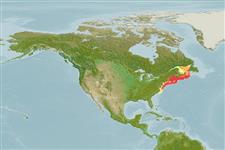Classificação / Names
Common names from other countries
Referência principal
Tamanho / Peso / Idade
Max length : 66.0 cm TL macho/indeterminado; (Ref. 40637); Peso máx. publicado: 3.6 kg (Ref. 40637)
Length at first maturity
Lm 26.0 range ? - ? cm
Ambiente
; marinhas demersal; oceanódromo (Ref. 51243); intervalo de profundidade 35 - 1152 m (Ref. 57178), usually 110 - 130 m
Clima / Intervalo
Temperate, preferred 9°C (Ref. 107945); 51°N - 33°N, 79°W - 58°W
Distribuição
Northwest Atlantic: North Carolina to southern Nova Scotia, straying to the Gulf of St. Lawrence. Rare European records are probably misidentifications of Urophycis tenuis.
Países | Áreas FAO | Ecossistemas | Ocorrências | Introduções
Descrição breve
Espinhos dorsais (total): 0; Espinhos anais 0. First dorsal fin ray elongated. Pelvic fins also reaching about the anal fin origin. Body color variable, reddish to olive brown dorsally, sometimes very dark or mottled; lower sides paler, sometimes with dusky dots; belly and underside of the head pale. A dusky blotch present on the opercle. The fins are generally dark, except for the pelvic fins, which are pale.
Categoria na Lista Vermelha da IUCN (Ref. 115185)
Ameaça para o homem
Harmless
Utilização humana
Pescarias: espécies comerciais; peixe desportivo: sim
Ferramentas
Relatórios especiais
Descarregue XML
Fontes da internet
Estimates of some properties based on models
Phylogenetic diversity index
PD50 = 0.5044 many relatives (e.g. carps) 0.5 - 2.0 few relatives (e.g. lungfishes)
Nível Trófico
3.7 ±0.3 se; Based on diet studies.
Resiliência
Médio, tempo mínimo de duplicação da população 1,4 - 4,4 anos (K=0.19; tm=2-3)
Vulnerabilidade
Moderate to high vulnerability (51 of 100)
Categoria de preço
